
This has been a journey that started with a decisiona decision to create a strategy that was built from the bottom up, one that was developed with the help of people who really know about the problems that this strategy addresses.
The communities of every nation have provided their perspective. They have shared their challenges and hopes for the future - and contributed their suggestions for how we need to think about the future of this mechanism.

It is vital that we honor the contributions and insights now gathered.








This is the beginning of a new story, of new possibilities. At the heart of this is violent conflict and all of the complex dynamics that surround such a difficult and emotive subject. This story is based on one of those genuinely wicked problems that we face in life:
• How to understand, respect and ultimately peacefully and objectively resolve differences.
• How to best make sure that the basic rights and necessities of those close to us are honored and provided for.
• How to promote and demonstrate the benefits of collaboration and negotiation - in the face of proud tradition and the honor of any community and its people.
All too often the outcome of any conflict is inequality and hardship, the experience is often violent and the price ultimately human life.
At the very heart of this sits human dignity – and the all too frequent loss of this most precious value.
Nations are far too accustomed to the wars, plagues and famines that come from simply being a diverse species on this planet. As we build the future we must try wherever possible to recognize and understand the tensions that we place on each other - either unintentionally or deliberately.
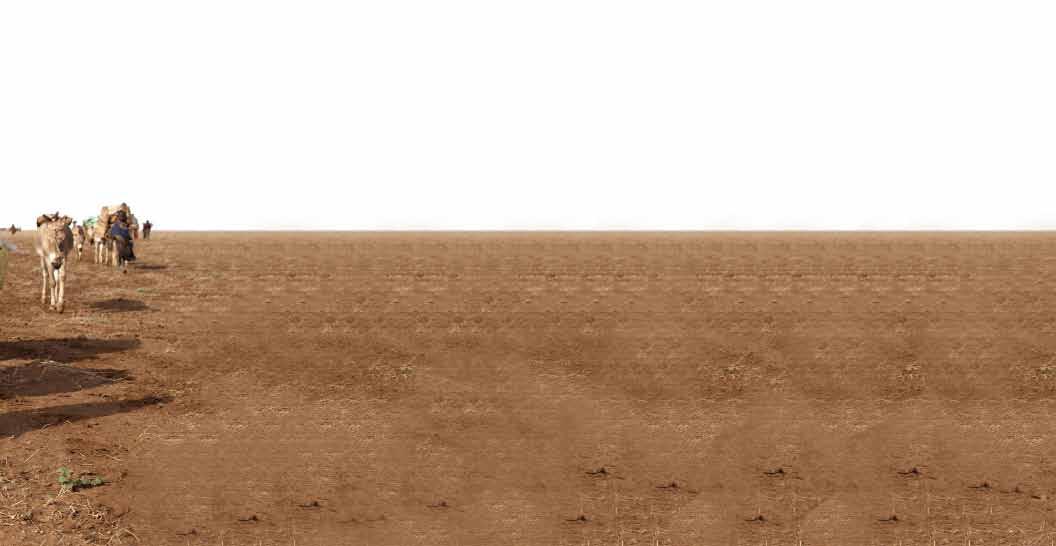
THE JOURNEY
BECOMING ‘MASTER BUILDERS’
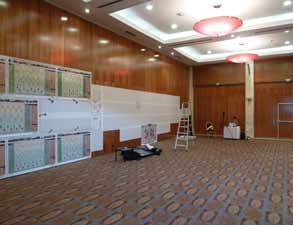

Building anything comes at a price. Building peace is a mighty ambition. There are things we need to help us do this.
WE NEED TO DEFINE THE SYSTEM OF CONFLICT

First we need to be masters at understanding and dealing with the complexity of conflict, to be able to look objectively at the forces and dynamics that spark conflict and then to appreciate the way that they can play out.
There is huge variability in the possible drivers, triggers and impacts – even this language is hard to define in a consistent manner. We have started to build taxonomy for the critical building blocks that define conflict and help us understand it better. We may change later – but this forms the basis of a common language that will be vital to our strategy and supports the visual framework examples that we have suggested. It is well worth the effort to get this right and applied consistently across our network.

The Dynamics – these are the influences in our worlds that are themselves shaped by global development. They simply exist and we typically can’t do much to alter them. We do, however have to be very aware of them and understand their potential influence in our environment.
The Drivers – the underlying triggers that lead to a potential conflict situation. They lead us to the root causes of conflict – but only when we understand the variability created by the dynamics.
The Sparks – the final ‘acts’ that lead to – or result in – conflict. Each time a set of dynamics and drivers collide - anywhere - an outcome of some kind is experienced, this is nature. In nature this is due to a constant balancing of energies and life forces competing for scarce resources. In our world all too often this results in a conflict and violence of some kind.
While conflict – or at least differences between people and communities – is normal and a part of life, violent conflict is arguably unnecessary and avoidable, and the cost of it is often completely underestimated.
We are a collective of passionate and dedicated people across all walks of life and areas of expertise – backed up by nations who have made a commitment to do something about it. We are the truest expression of a value network and the CEWARN mechanism provides us with a common framework against which we can operate and fully leverage the knowledge and wisdom that exists on this topic.

What we have within our network - the mechanism, the organizations and the structures - is already proving that there is huge benefit in joining forces to minimize and even prevent conflict. The last ten years have taught us a lot and there is much more to be learned – and greater effectiveness to be achieved.
As we embark on this new phase we take with us everything we have learned and build on it to create a new strategy that will result in a stronger network, a more proactive and agile mechanism and more ways to achieve sustainable peace.
STRATEGIES DESIGNED TO COPE WITH DYNAMIC CHANGE


Strategies are merely stories. Our story has been deeply thought through and built from the grass roots, and this framework aims to do justice the immense work done. Only a fraction is illustrated here.
Strategies have an end point in mind but may not get there, strategies have the most important elements in them - what are we trying to achieve, what are we trying to solve and what do we need to do to get there. These are continuous questions and the answers will vary over time depending on any number of variables.
That is why we have contained and organized our story in this framework. We will explain.
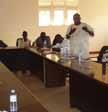
OUR CHALLENGE
Alerting, monitoring and responding as well as reporting and measuring these things across whole countries and their borders is one of the most complex mechanisms imaginable. When we take a closer look at what’s really going on this ‘system of things’ becomes wickedly complex.
A fundamental objective is to anticipate and respond to potential conflicts earlier. In getting out ahead of these conflicts we - the whole network - are in the business of information superiority – at the intersection of analytics, pattern recognition and interpretation – spotting and identifying those dynamics and drivers - as far ahead as we can - in order to avoid the sparks, or at least to minimize the effect of the sparks that do ignite.
National Assessments
DESIGNERS, ARCHITECTS AND ENGINEERS

In building anything on this planet we need the best designers, architects, engineers and operators that we can find. And all of these ‘actors’ need the best ‘brief’ and the best materials and resources to work with.
• Our materials and resources are primarily the data and insight that we have been gathering from every perspective possible and at every level – local, national and regional – to understand what was needed.
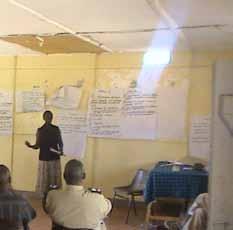
• We have a comprehensive brief that represents those who have the best insight into the challenge – supported by a clear mandate from those who govern and support us.
• We took the material provided and we refreshed the vision and our commitment –we described the ideal for CEWARN.

• We framed the way we need to evolve the model and started to build the strategy that will be the exemplar of how conflict can be minimized and dignity for all can be the more than an aspiration.
• We have evolved from a group of organizations bound by a mechanism and protocol into a ‘value network’ of equal partners with a singleminded goal of delivering the mission.
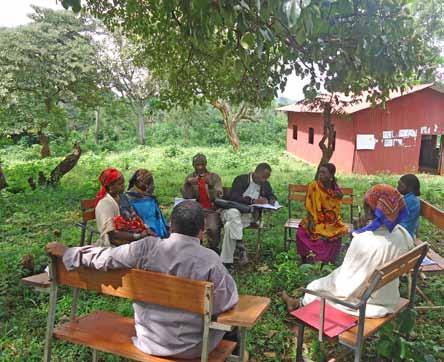
A SMART JOURNEY TO DIGNITY LAND

We have created a ‘Peace Architecture’ - in effect a ‘System That Identifies, Enables & Sustains Peace. Dignity Land is a place everyone deserves. Dignity is a human right. Our business is singularly focused on the early identification of threats to peace and dignity - our rights as individuals, communities and nations.


SIMPLE BUT NOT SIMPLISTIC
Conflict and the causes of conflict quickly creates a wildly complex picture. Our strategy and operational framework simplifies without patronizing, clarifies without dumbing down and narrates with respect all the many perspectives and actors involved in our journey.
THE JOURNEY TO DIGNITY LAND REQUIRES THE RIGHT EQUIPMENT

It’s a difficult path littered with paradox, dilemma and hard choices. Our approach honors the specifics and intangibles equally. We are active listeners, diplomats and alchemists conjuring with what we learn. Every piece of information we gather is a clue to us and ultimately a suggestion for how to act. It is a highly prized insight for everybody involved.
This complexity increases in direct proportion to our ability to comprehend it. This means the more we know the more we need to know. It is exponential. As technology empowers us more then the more enabled we need to become.
A DATA-VALUE CHAIN
A primary piece of our equipment is our knowledge of the data and where and how that informs high quality decisions across the Value Chain. This level of ‘information mastery’ makes us as smart as the clues in the data. We do this by recognizing these as repeated patterns and that means we can act faster and faster as we learn more and more.
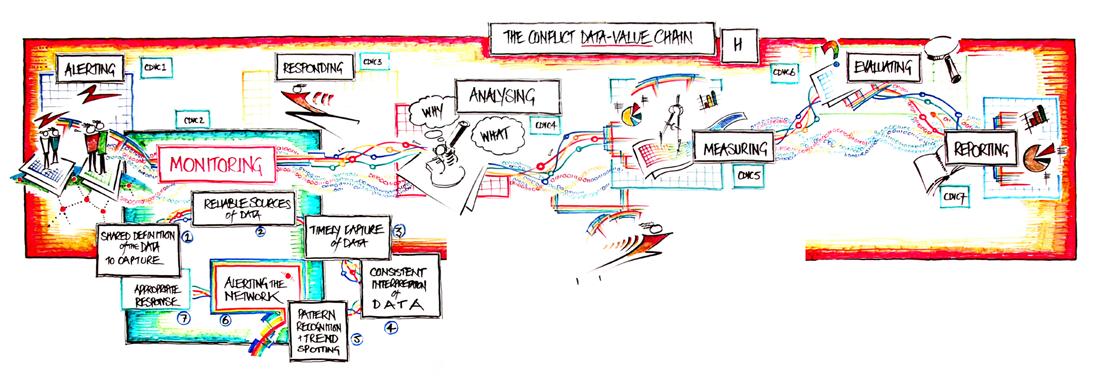
Data is a small word that hides a massive weapon if we can master it. Left to its own devices it will kill us, armed with out devices to master it, it can be tamed and be our biggest ally in the war against the situations that would undermine peace and dignity.
This data when turned into informational value is the oxygen that runs through our highly connected network of partnersequal partners with the aim of connecting and owning in this way to remove the prospect of conflict before it become real.
DATA IS THE NEW OIL



We (in the widest sense) all appreciate the value of precious natural resources - and we respect the process and energy that is required to cultivate them to a point where they deliver real value. In those resources that deliver tangible (and personal) value such as wealth the motivation to work through the process is much higher.
Data is as much a natural resource that requires cultivation to convert it to insight and knowledge - this is an equally iterative process and one that comes with much more complexity and consequence and much less immediate personal gain (on many occasions). It requires significant mental discipline, patience and dedication to harvest the value that is typically hidden from view initially.
If we can elevate data to the same level of importance and see it as a currency that we exchange across the network we will unlock huge potential and value for the collective good and at the same time ignite passion for learning and leverage of the data that already exists among a much wider group.
The vital numbers
• We have created 10 Principles that will start to shape our perspective on the way we navigate the complexities of conflict.
• We have 6 Areas of focus that drive our program of improvement as we face and address our challenges and leverage our strengths.
• We have 7 Layers of evolution and enablement that embrace excellence from wherever it may come from.
• And we have 1 Unified Approach - a value networka partnership of equals across the whole region and the emerging model for the world.
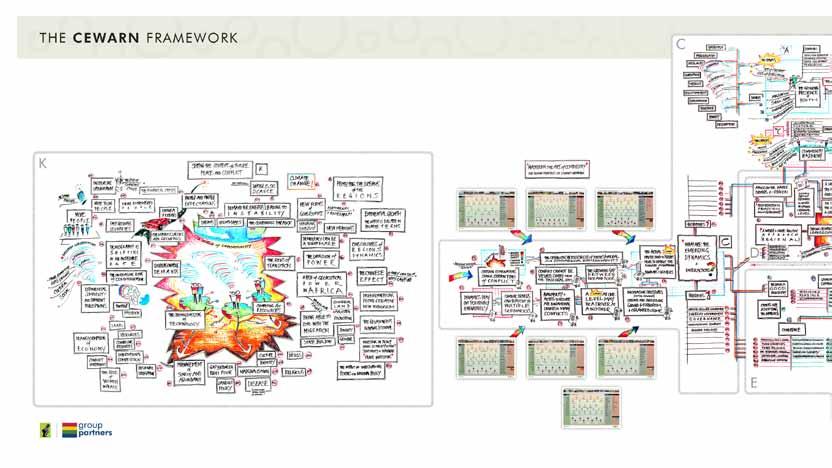
• All of this built on 1 Set of standards, principles, structures and capabilities.
THIS IS OUR PEACE ARCHITECTURE –and one that can become an exemplar in the world of conflict. It will operate in the widest arena, it will respect and interact with the
other structures and initiatives that exist to tackle conflict – locally, nationally, regionally and internationally. And we hope these other models will embrace this architecture equally.

EXPLAIN FULLY WHAT
SEE HERE...
NOW LET’S
YOU
THE EXISTING AND EMERGING DYNAMICS
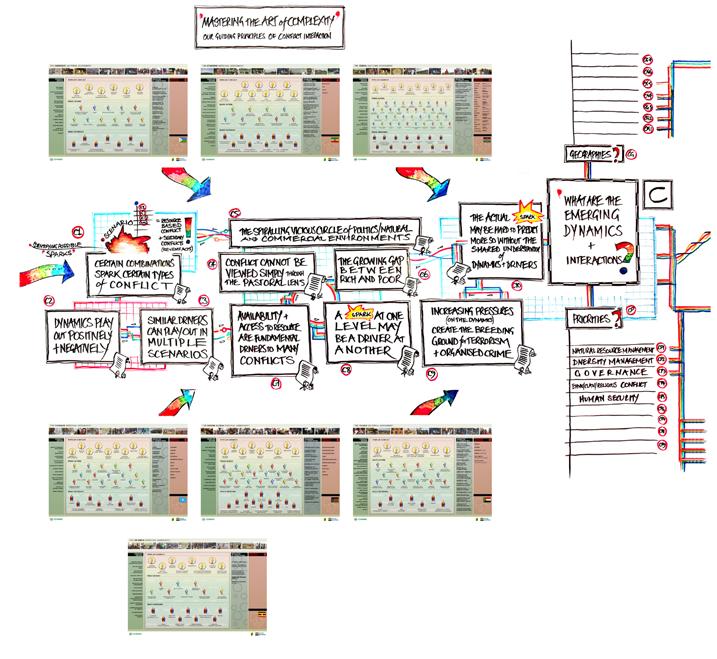
At the beginning of this framework are the dynamics that we discussed together – the ones that we have been gathering through the dialogues and the new trends that we need to be aware of.
Even though this brief discussion we started to build new insights into these dynamics that are important for us to remember, in many ways they are simply truths and realities but nonetheless valuable reminders of how to navigate this context. These have emerged as a set of ‘principles’ for mastering the art of

complexity and we may well build on these as we take the program forward.
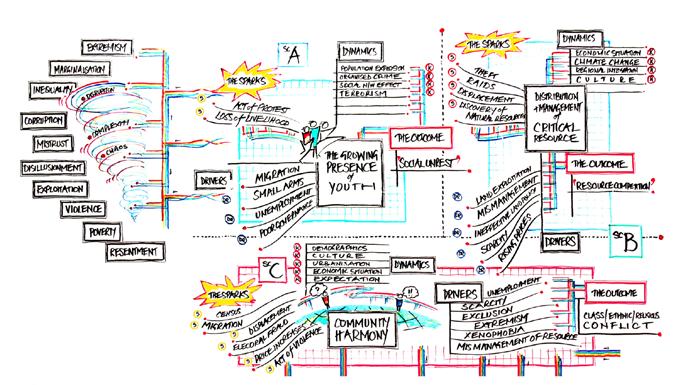
The inevitable debate occurred over language and definition – what is a Dynamic and what is a Driver? And are these even the right terms to apply here? We don’t have a firm conclusion yet and so have stayed true to the language in the framework – this is something we will resolve.
To help we created three example scenarios that build on the work done in groups to identify the critical interactions between these dimensions.
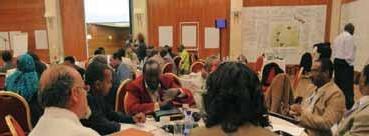
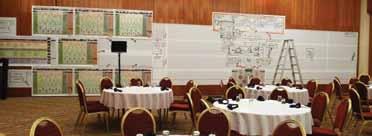

C
THE IDEAL FOR CEWARN
In this module we talked about how our network and the mechanism could and should evolve. This is the emergence of the value network and the inspiration that led us to shape the strategy in this way.
In here is a very summarized distillation of the ideas and perspectives represented on the room. We were able to distill to this level of simplicity only because the views expressed were in complete harmony.

D

THE STRENGTHS AND WEAKNESSES OF THE MECHANISM
Given the issues that this mechanism addresses and the diverse mix of actors contributing to its operation, it is hardly surprising that there are challenges that need to be addressed by this strategy. And while it is right to be critical of these weaknesses we must equally recognize and reflect on what makes it such a powerful concept, and build on that while improving what we have today.

To help us focus on these points so that we move forward with tangible actions we have grouped the insights into six primary themes. In each there are strengths and weaknesses and there are some valuable clues to be gained by comparing the two.
At this stage there is no deliberate alignment between the strengths and weaknesses in each theme or suggestion of how we will achieve a better balance between them. As the strategy evolves we will be paying close attention to how we will address the weaknesses and make sure that we are able to fully leverage the strengths.

E
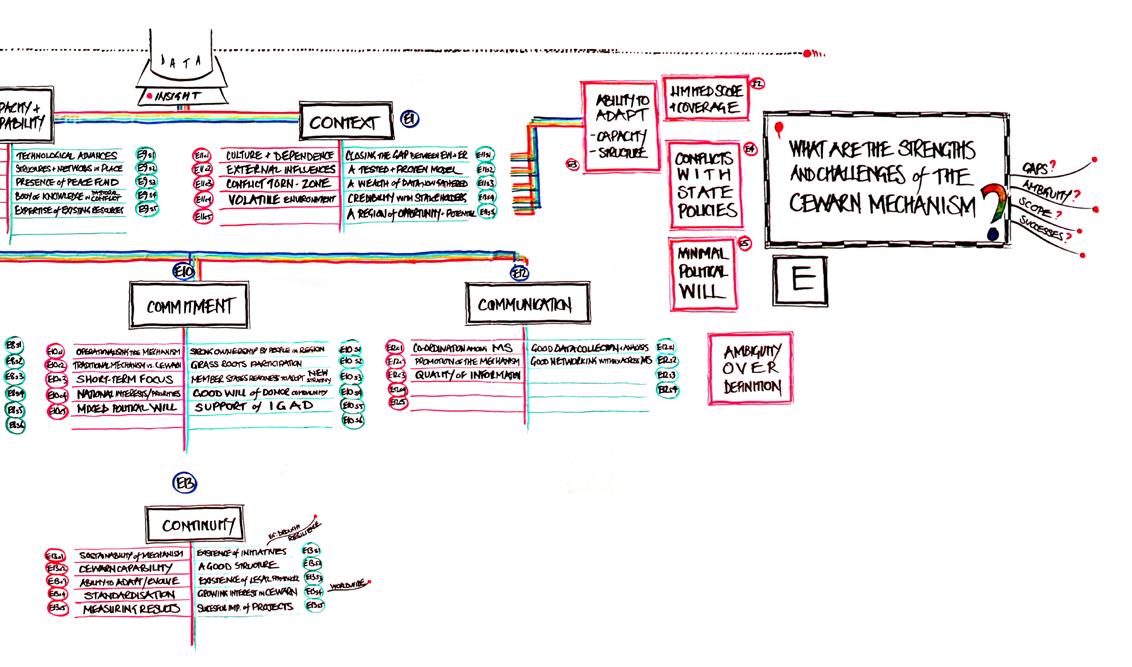
WHAT CAN WE LEARN AND WHO SHOULD BE INVOLVED?
These two modules were combined into a single exercise and discussion as they are closely linked and we could only begin to address this give the wealth of insight that we know could be harvested and the numerous actors who we can work closely with and learn from. Many of these are already a part of our eco-system – the value network – and this is more about making sure that our network is operating as effectively as it possibly can within the context and every changing dynamics that make up our world.
We pictured this as a spiral of growing awareness where we can continue to develop the network in a systemic and holistic way starting from the bottom with the establishment of the Peace Architecture – our foundation

F&G
and building on top of that the various disciplines and capabilities that will contribute to making this the best network we could imagine - ultimately developing mastering in the way we deal with the complexity and dynamics of conflict.
This mastery will show up across the Data Value chain that we have started to define. Each activity will be governed by our shared standards and definitions for managing the data that is the lifeblood of this process – we have shown how this might work within one example (Monitoring) and the same could be applied to each one. All of this would be aligned to the evolution of our network with the primary aim of faster, earlier warning and the most effective and appropriate resolution.

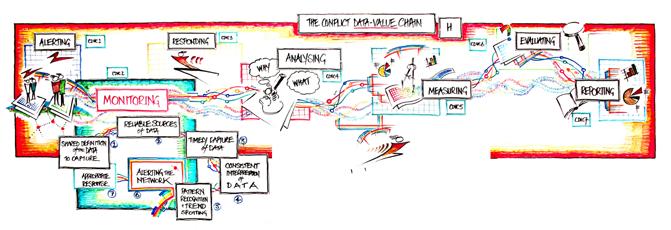
H –
THE OPTIMAL VALUE NETWORK
And finally, we have created a hypothesis for what this network will become and how we can picture the collective that makes us the mechanism, the actors and the capabilities and data – this is CEWARN as a system and we have imagined a model that is able to continually evolve and adapt to changing dynamics. It is a network of actors who share a common purpose and can speak about conflict with a common language. The network is able to connect at the critical intersections, to collaborate and share and to know when to act, when and who to alert, when and who to advise and when and who to consult.
The consistency that has been established enables maximum collaboration without constraining individual Nations or Organizations. It constantly harvest and makes available new information and understands the contributions that every member makes.
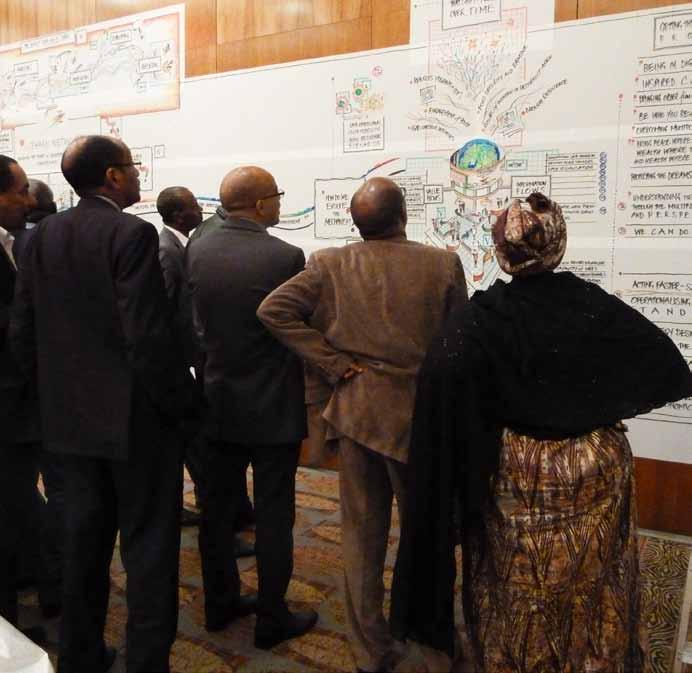


SUMMARY....
Martins copy to go here...

http://www.grouppartnerswiki.net/index.php?title=Wicked_Problems

REFERENCES....























































